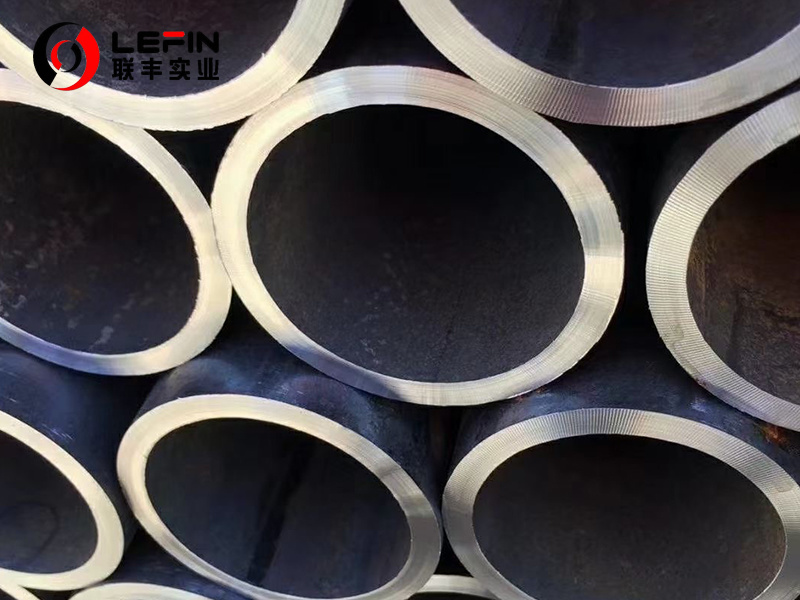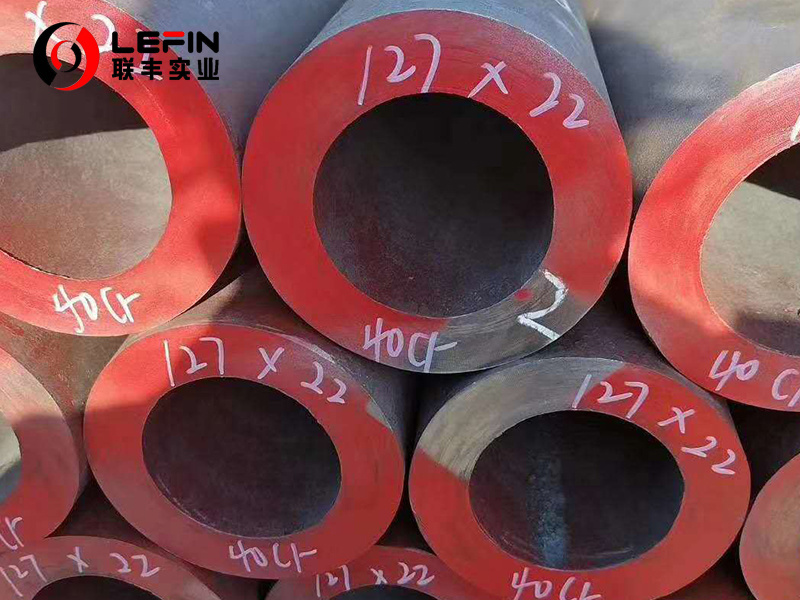



- Details
-
ASTM A519 standard covers the specific requirements for carbon steel and alloy steel seamless tubes for machinery.
Project Specific description Standard Standard Specification for Seamless Carbon Steel and Alloy Steel Mechanical Tubes Core process Seamless, mainly made through hot working (hot rolling/hot expanding) or cold working (cold drawing/cold rolling) Main shape Circular, square, rectangular and with special cross-sections Key steel grade Carbon steel series: 1020, 1025, 1026, etc.;
Alloy steel series: 4130, 4140, etc
Main application scenarios Mechanical manufacturing (hydraulic cylinders, bearings, shafts), automotive parts, oil and gas equipment, building structures, etc 🔩 Chemical composition and mechanical properties
ASTM A519 standard has clear requirements for the chemical composition and mechanical properties of different steel grades, which is the basis for ensuring the performance of materials.
• Chemical composition:
The standard specifies the specific range of chemical composition for each steel grade. For instance, the composition comparison of common 1020 carbon steel and 4130 chromium-molybdenum alloy steel is as follows (please refer to the original standard for specific values) :
Carbon steel 1020:Carbon (C), manganese (Mn), phosphorus (P), and sulfur (S) are the main control elements, and the content of alloying elements is low.
Alloy steel 4130: In addition to the basic elements, it also contains chromium (Cr) and molybdenum (Mo), thereby achieving higher strength, hardness and hardenability.
• Mechanical properties:
The mechanical properties of materials (such as tensile strength, yield strength, and elongation) are closely related to their heat treatment state. The standard defines performance indicators under different states, such as:
- Annealing (A) : Softens the material, facilitates processing, has relatively low strength, and good plasticity.
- Normalizing (N) : Homogenizes the structure, giving it balanced strength and toughness.
- Stress relief (SR) : Eliminates cold working stress, with strength between annealing and normalizing.
- Cold working (CW) : Strength is enhanced through cold deformation, but plasticity decreases.
🏭 Manufacturing and quality requirements
To ensure the quality of steel pipes, ASTM A519 standard has a series of regulations in the manufacturing and inspection links.
• Manufacturing process:
Steel pipes are formed through hot working (such as hot rolling and hot expanding) or cold working (such as cold drawing). Cold-worked steel pipes usually need to undergo heat treatment at 1200°F (about 650°C) or higher.
• Dimensions and shapes:
The standard covers a wide range of dimensions, for instance, the outer diameter can range from approximately 10mm to over 350mm, and the wall thickness can vary from less than 1mm to 50mm. There are also corresponding requirements for the straightness and surface quality of steel pipes.
• Quality Inspection:
Before leaving the factory, steel pipes need to undergo a series of strict inspections, usually including:
- Chemical composition analysis
- Mechanical property tests (tensile tests, hardness tests, etc.)
- Process performance tests (flattening test, flaring test, bending test)
- Non-destructive testing (such as eddy current testing
- Hydrostatic test
💎 Summary and application selection
All in all, the ASTM A519 standard provides authoritative technical basis for seamless tubes used in mechanical structures that require high strength, high precision and good comprehensive performance. Its value lies in ensuring the reliability of the product under various harsh working conditions through standardized material and process requirements.
When making an actual selection, you can refer to the following ideas:
• Clarify the service conditions:First, consider the type of stress (static, dynamic, impact) that the component needs to withstand, the pressure level, the working temperature and the corrosive environment, etc.
• Match the steel grade and condition:
Based on the above conditions, select the steel grade and its heat treatment condition that can meet the core performance requirements (such as strength and toughness). For instance, 4130 and 4140 alloy steels are typically used in applications requiring high strength and wear resistance.
• Pay attention to dimensional accuracy:
If there are high requirements for assembly accuracy, special attention should be paid to the dimensional tolerance level of the product.


ASTM A519 SMLS PIPE
Subcategory
Keyword
- Details
-
ASTM A519 standard covers the specific requirements for carbon steel and alloy steel seamless tubes for machinery.
Project Specific description Standard Standard Specification for Seamless Carbon Steel and Alloy Steel Mechanical Tubes Core process Seamless, mainly made through hot working (hot rolling/hot expanding) or cold working (cold drawing/cold rolling) Main shape Circular, square, rectangular and with special cross-sections Key steel grade Carbon steel series: 1020, 1025, 1026, etc.;
Alloy steel series: 4130, 4140, etc
Main application scenarios Mechanical manufacturing (hydraulic cylinders, bearings, shafts), automotive parts, oil and gas equipment, building structures, etc 🔩 Chemical composition and mechanical properties
ASTM A519 standard has clear requirements for the chemical composition and mechanical properties of different steel grades, which is the basis for ensuring the performance of materials.
• Chemical composition:
The standard specifies the specific range of chemical composition for each steel grade. For instance, the composition comparison of common 1020 carbon steel and 4130 chromium-molybdenum alloy steel is as follows (please refer to the original standard for specific values) :
Carbon steel 1020:Carbon (C), manganese (Mn), phosphorus (P), and sulfur (S) are the main control elements, and the content of alloying elements is low.
Alloy steel 4130: In addition to the basic elements, it also contains chromium (Cr) and molybdenum (Mo), thereby achieving higher strength, hardness and hardenability.
• Mechanical properties:
The mechanical properties of materials (such as tensile strength, yield strength, and elongation) are closely related to their heat treatment state. The standard defines performance indicators under different states, such as:
- Annealing (A) : Softens the material, facilitates processing, has relatively low strength, and good plasticity.
- Normalizing (N) : Homogenizes the structure, giving it balanced strength and toughness.
- Stress relief (SR) : Eliminates cold working stress, with strength between annealing and normalizing.
- Cold working (CW) : Strength is enhanced through cold deformation, but plasticity decreases.
🏭 Manufacturing and quality requirements
To ensure the quality of steel pipes, ASTM A519 standard has a series of regulations in the manufacturing and inspection links.
• Manufacturing process:
Steel pipes are formed through hot working (such as hot rolling and hot expanding) or cold working (such as cold drawing). Cold-worked steel pipes usually need to undergo heat treatment at 1200°F (about 650°C) or higher.
• Dimensions and shapes:
The standard covers a wide range of dimensions, for instance, the outer diameter can range from approximately 10mm to over 350mm, and the wall thickness can vary from less than 1mm to 50mm. There are also corresponding requirements for the straightness and surface quality of steel pipes.
• Quality Inspection:
Before leaving the factory, steel pipes need to undergo a series of strict inspections, usually including:
- Chemical composition analysis
- Mechanical property tests (tensile tests, hardness tests, etc.)
- Process performance tests (flattening test, flaring test, bending test)
- Non-destructive testing (such as eddy current testing
- Hydrostatic test
💎 Summary and application selection
All in all, the ASTM A519 standard provides authoritative technical basis for seamless tubes used in mechanical structures that require high strength, high precision and good comprehensive performance. Its value lies in ensuring the reliability of the product under various harsh working conditions through standardized material and process requirements.
When making an actual selection, you can refer to the following ideas:
• Clarify the service conditions:First, consider the type of stress (static, dynamic, impact) that the component needs to withstand, the pressure level, the working temperature and the corrosive environment, etc.
• Match the steel grade and condition:
Based on the above conditions, select the steel grade and its heat treatment condition that can meet the core performance requirements (such as strength and toughness). For instance, 4130 and 4140 alloy steels are typically used in applications requiring high strength and wear resistance.
• Pay attention to dimensional accuracy:
If there are high requirements for assembly accuracy, special attention should be paid to the dimensional tolerance level of the product.


Related products
Product Consulting

Address: Hengtai Road,Daqiuzhuang Town,Jinghai County,Tianjin,China
Mob: +8615122229899(whatspp)
Phone: +86 22 58171905
Fax: +86 22 58171902
E-mail:info@lefinsteel.com
Get company updates

Tianjin Lefin Industrial Co.,Ltd. All rights reserved City sub-station SEO www.300.cn

